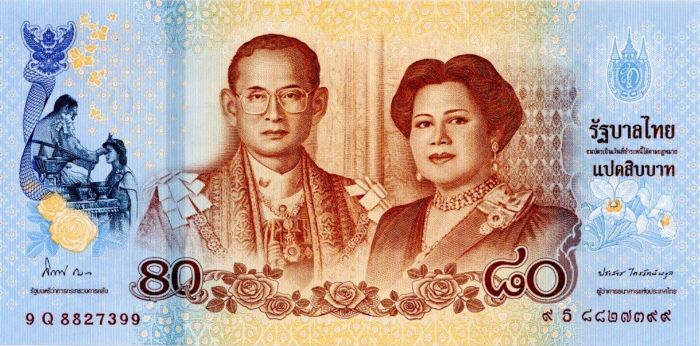Thailand - P-125 - 80 Bahts - Foreign Paper Money
Inv# FM2101 Foreign Paper Money Cat# P-125
80 Bahts, P-125. The history of Thai money used as a medium of exchange and to settle accounts before the adoption of Thai baht coins and banknotes include novel designs and forms. For Thai people, money was considered as the symbol of civilization. Currency itself reflected faith in religion, culture, the customs and traditions of each era and also serve as a record of the development of Thailand. The land which is now Thailand was once inhabited by various pre-historic communities. These groups of people left a heritage of social culture and ceremonies. In the ancient days of Thai society, before money was created to serve as a medium of exchange, humans traded goods by bartering for products of similar value. However, many products differed in quality, and buyers and sellers differed in their assessments of value and in their requirements. To facilitate product sales, several mutually-agreed commodities came into use as mediums for exchange.
The Indo-China Peninsula or "Suvarnabhumi" which means 'golden peninsula', was the geographical area on which Thailand is presently situated. These ancient kingdoms were a prosperous homeland for a variety of diverse races and tribes. They were the regions that were later on known as the Funan Kingdom, Dvaravati Kingdom, Srivijaya Kingdom, and Sukhothai Kingdom. They used money as a medium of exchange which evolved into different forms of money. Thai money has the unique characteristics of the Thai nation with the Sukhothai Kingdom, using round shaped money made from silver which was known as "pod duang", and has been continued from that time down to the Ayudhya, Thonburi and the early Rattanakosin periods. Read more at https://en.wikipedia.org/wiki/History_of_Thai_money










Ebay ID: labarre_galleries